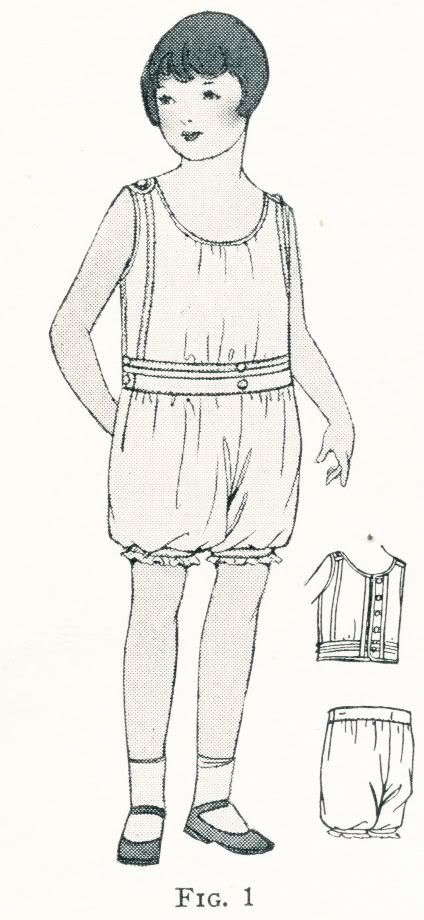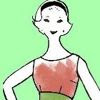
"An attractive short negligee, generally known as a bed jacket, is shown in Fig. 4. It consists merely of a rectangular section of material cut according to the diagram at the upper left and having all its edges bound with a harmonizing color. As such a garment does not receive hard wear and as a dainty effect is desirable, the light colors, such as flesh, pink, blue, orchid, and yellow, are preferred. Any of these, bound with a lighter or a darker shade or with a color that combines well with it, such as orchid with pink or yellow, would be most effective. Tiny flowers, made of narrow ribbon or heavy embroidery floss in pastel colorings, provide a dainty trim around the neck and on the sleeves, while two-tone ribbon forms ties at the front neck and the under arms."
"Proper-fitting, adjustable brassieres are an actual necessity for the prospective mother. These may be of various types, depending on the figure, and the adjustment may be in the front or back, as preferred. In Fig. 1, views (a) and (b) show brassieres suitable for the large, full figure, view (a), made entirely of a figured sateen, being the type that closes in the back with waist-Iine ties fastened in the front, and view (b), the front opening type fastened with hooks along the side-front seam and made further adjustable by inserts of elastic webbing. Such a brassiere becomes useful as a nursing type after the baby's birth."
I looked and looked at this illustration and finally figured that the "great convenience" for the mother was the use of ties that "certain authorities" recommended and this illustration was the layers that you set out for one change of clothing, "each one fastened securely without turning the baby once".

"Certain authorities, interested in baby welfare and advocating simplicity of cut in garments, recommend opening them their entire front or back length, but front preferably, and fastening them with tape rather than buttons and buttonholes, as shown in Fig. 37. Such a plan proves a great convenience to the mother, for the garments can be arranged in their right order, one on top of the other, as shown here, the baby then slipped into them with great ease, and each one fastened securely, without turning the baby once. The chief essential, in using such a layette, is to see that each article is arranged smoothly with shoulder lines together so that, when the tapes are tied, there will be no wrinkles to smooth out.
Patterns for layettes of this kind can be procured, so, if you are interested in using garments that will require very little handling of the baby in putting them on and taking them off, it is well to make such a layette. Of course, it will be necessary for you to sacrifice your desire for attractive little dresses and slips, as such a plan necessitates plainer, more substantial garments, and a full-length opening naturally prevents the dainty trimming effects that make baby clothes so pretty."
This includes photos and complete instructions to make most of the items shown, after all you were expected to become an accomplished seamstress using these books. But this next drawing with some of the accompanying photos show how much detail went into garments, even for a childs underwear!

"Some mothers consider it practical to buv underwaists ready-made, and when time is a very important itern they are fully justified in this idea, for the amount of labor that is involved in their development should be a important consideration for busy mothers.
From the standpoint of actual cost, however, the making of underwaists involves a saving. Then, too, the quality of material used may be of the best and the labor may be reduced to a minimum if sewing-machine attachments are employed and the style illustrated in Fig. 1 is followed."

This bit about Blouses for boys explains exactly how much embroidery you may add "to very good effect", but don't get carried away and don't add any after the age of 6!"

"Blouse for boys are of two general types; the overblouse of the jumper, middy, and Russian-blouse type, and the tuck-in blouse. Both of these types are worn interchangeably with the same trousers, making greater variety possible.
Overblouses, with the exception of middies, are suited only to boys of 6 years or less. Middies may be worn by boys up to 12 years or even older, with either long or short trousers. Tuck-in blouses, being more in the nature of shirts, are suitable to boys of all ages. Sometimes in suits for boys of from 2 to 4 years, they are sewed to the trousers at waist line, making a one-piece suit in two-piece effect.
A great many variations in cut and trimming are possible within the narrow limits of these two types of blouses, so that the mother who is alert to individual touches may have them in plenty on her little son's suits. Though embroidery is considered feminine, it is possible to use small amounts of it to very good effect on the blouses of small boys, if carried out in conventionalized designs with simple stitches. Finely plaited frills and tiny jabots are not objectionable on very small boys, nor are tucks and stitched-in plaits in the fronts of blouses. When a boy passes his sixth year, however, the more tailored and masculine his clothes are, the better he will like them, and the more suitably dressed he will appear."


I remember my mother teaching me how to dress my first daughter and she laid out all the clothes like the illustration and told me that way I wouldn't have to worry about wrinkles making sores on the skin and that it would keep the belly button in place so as not to cause pain, and that was just 3 years ago!
ReplyDelete